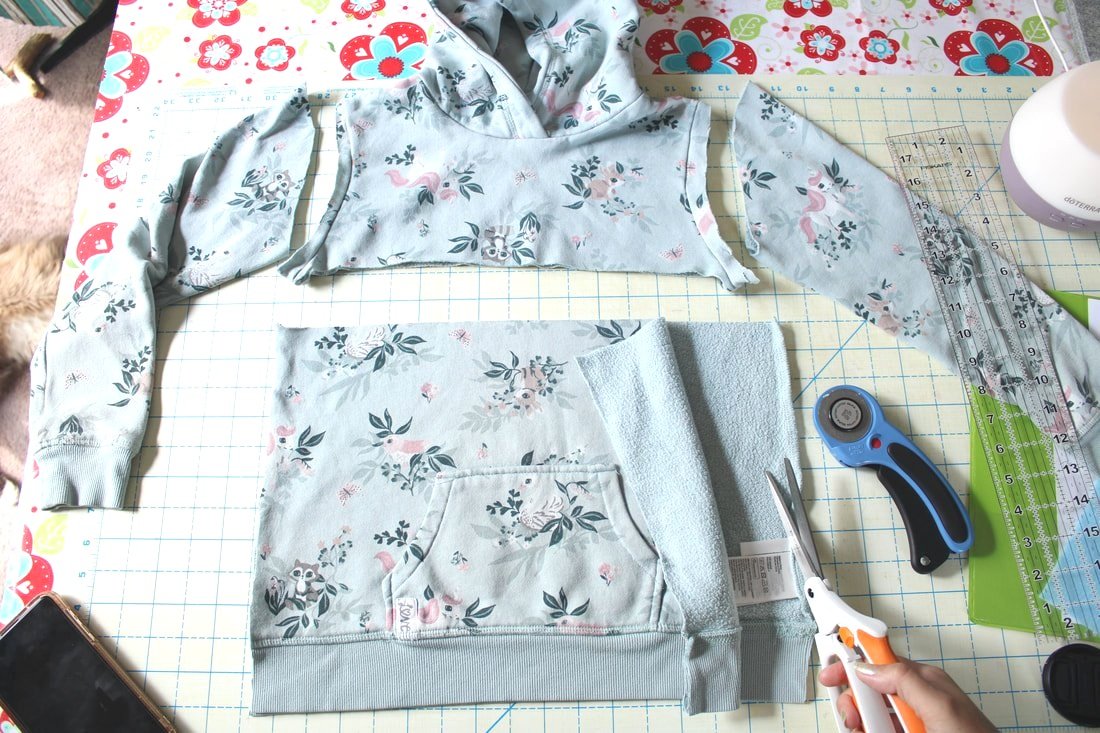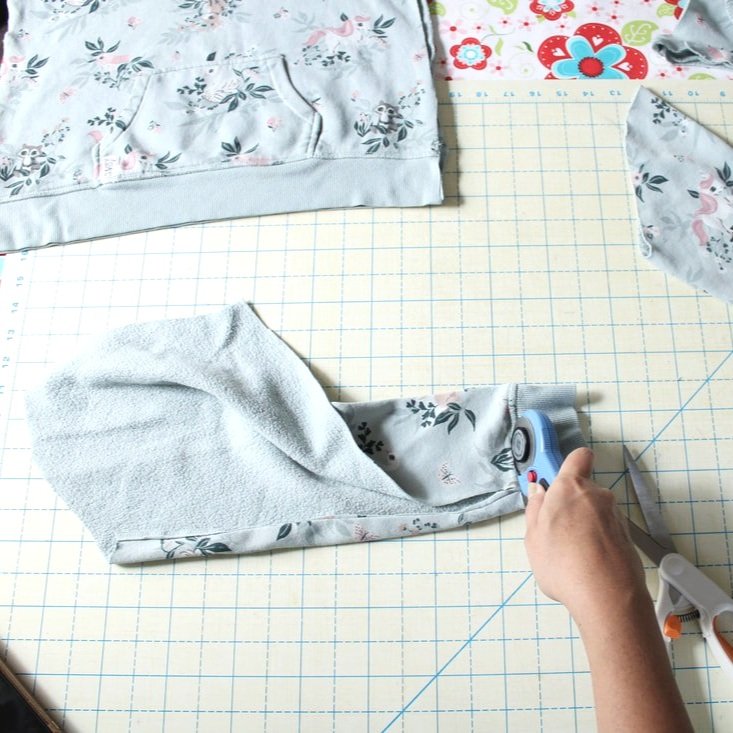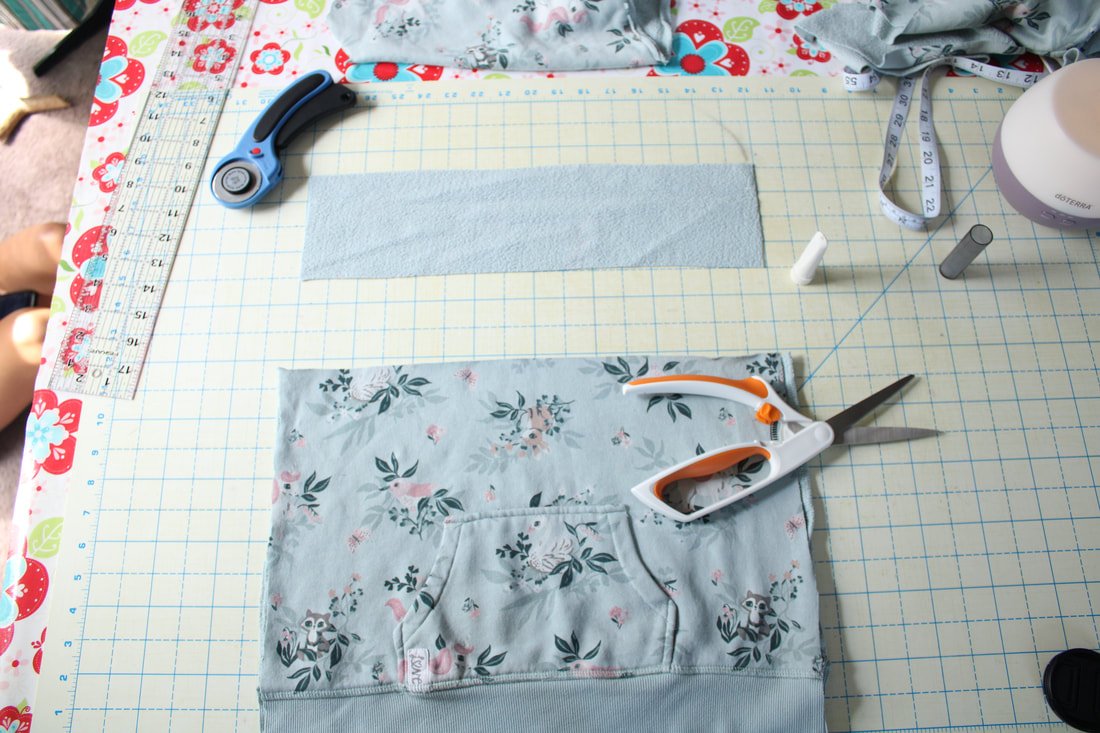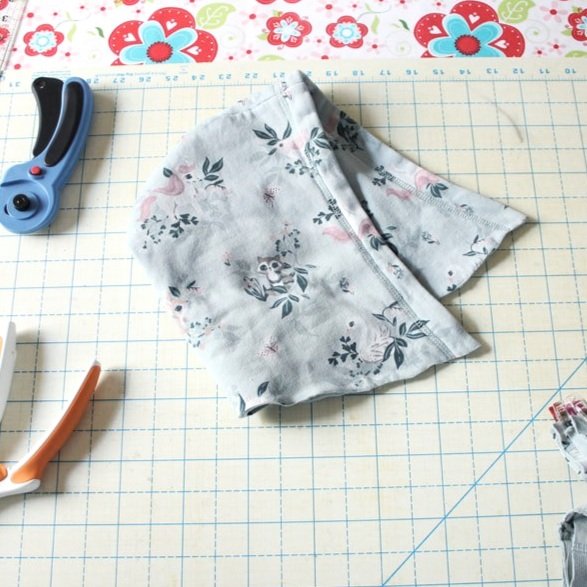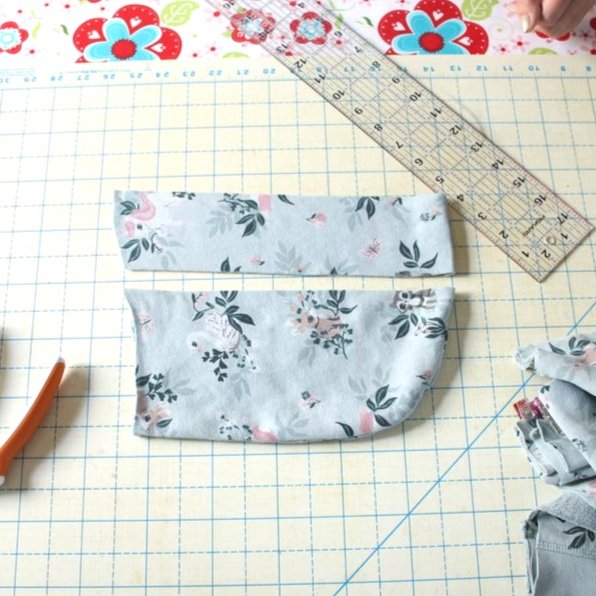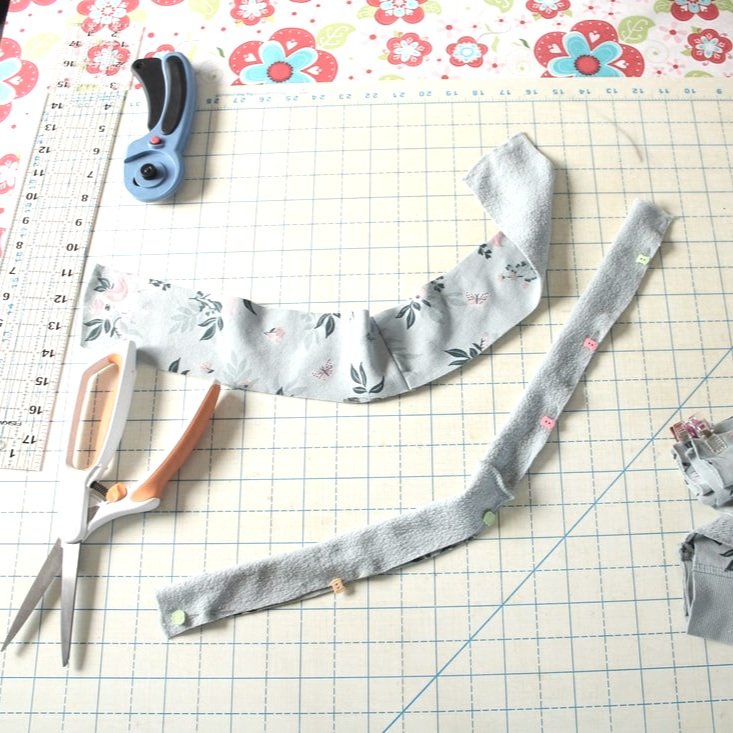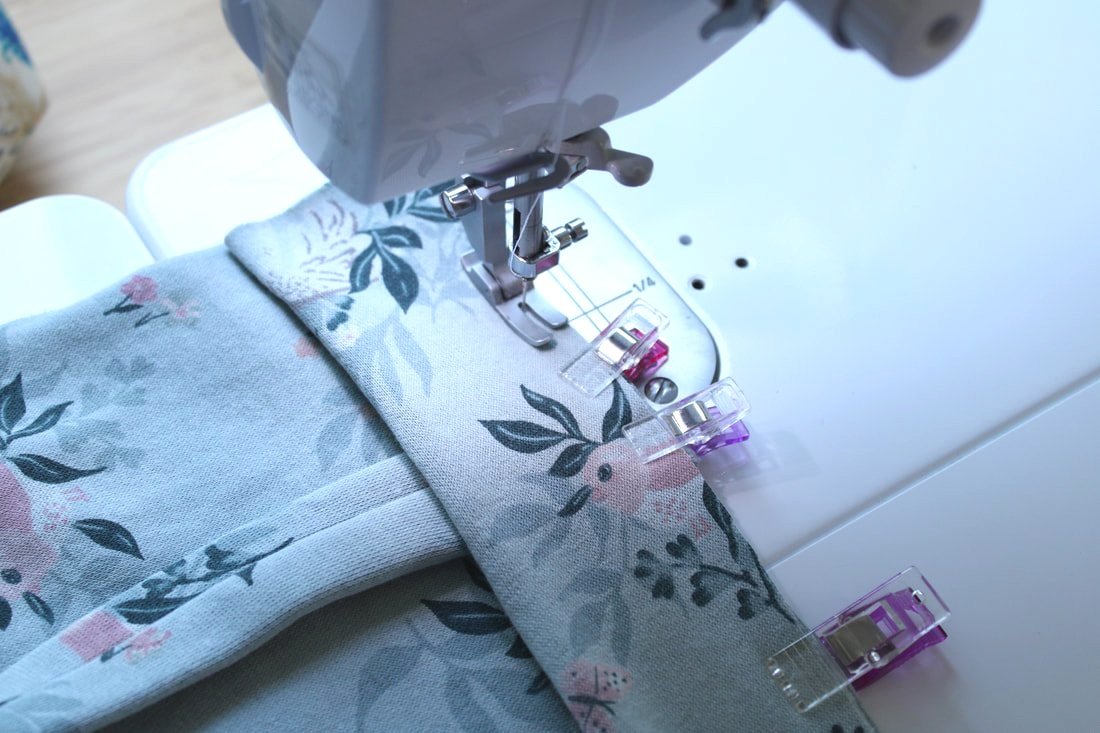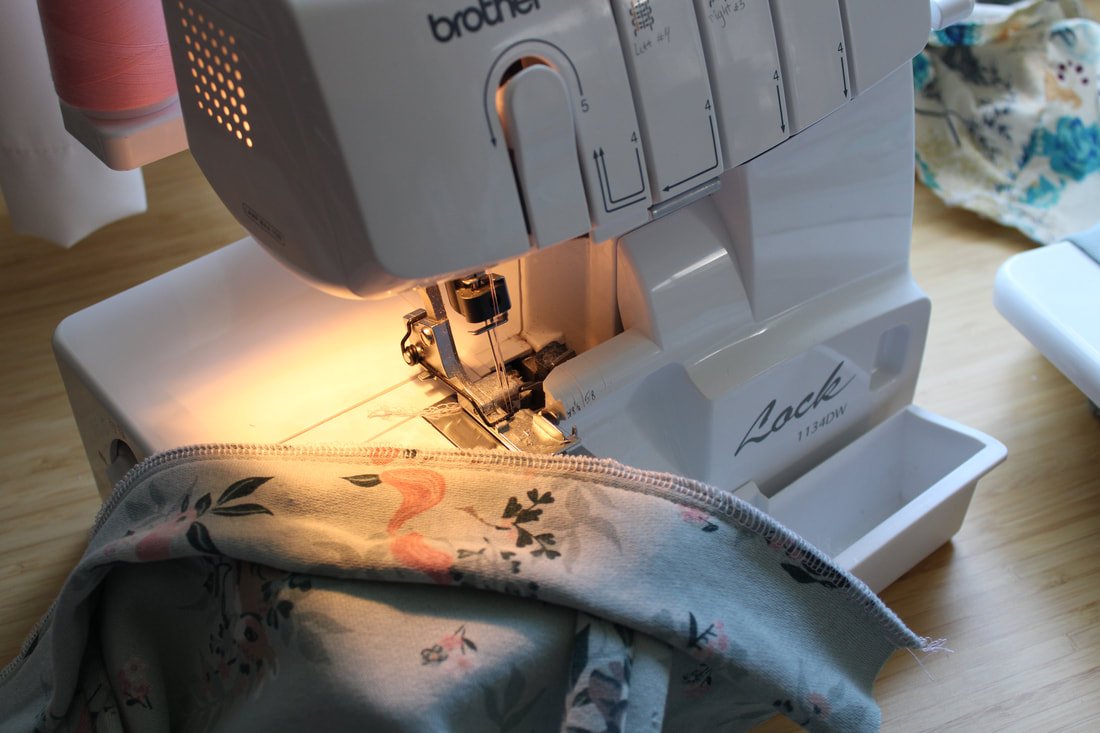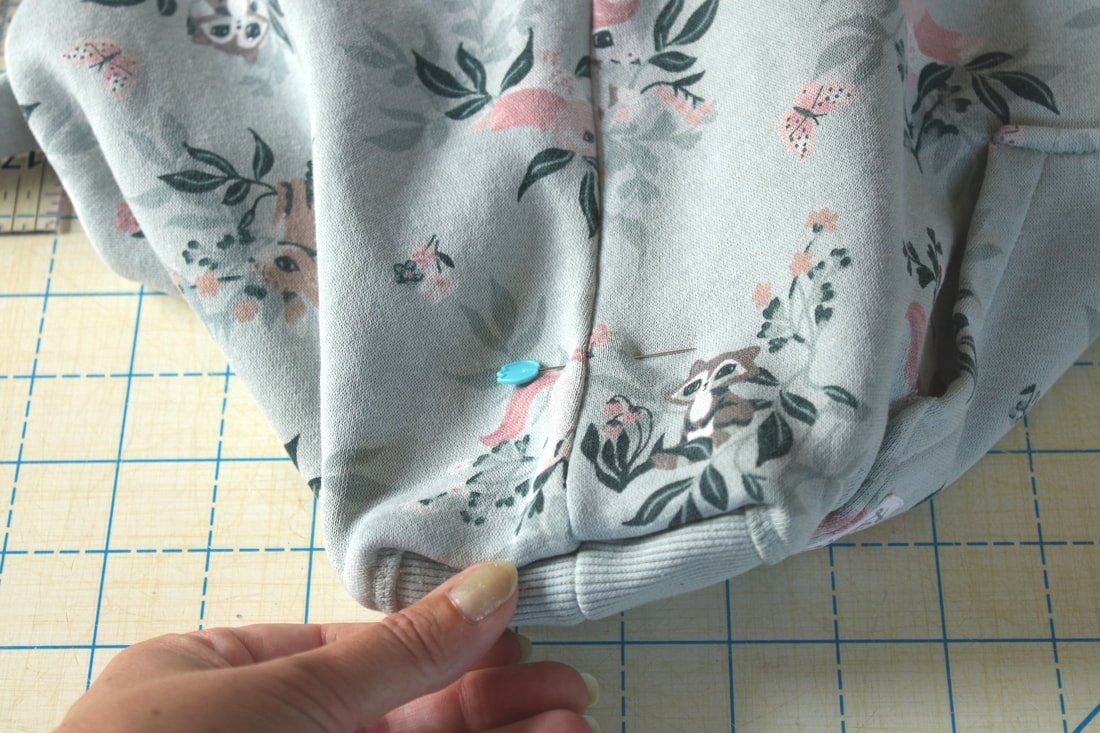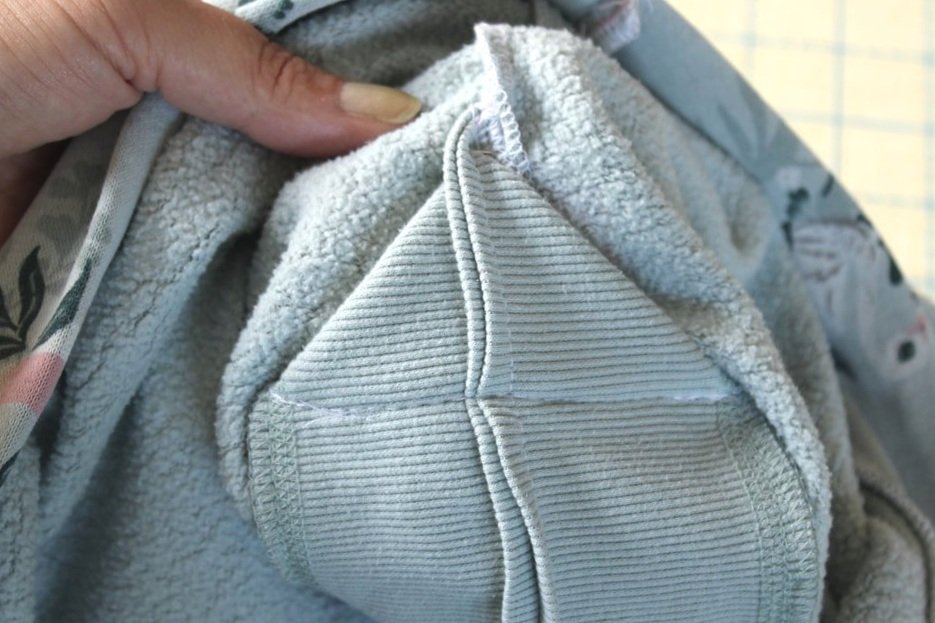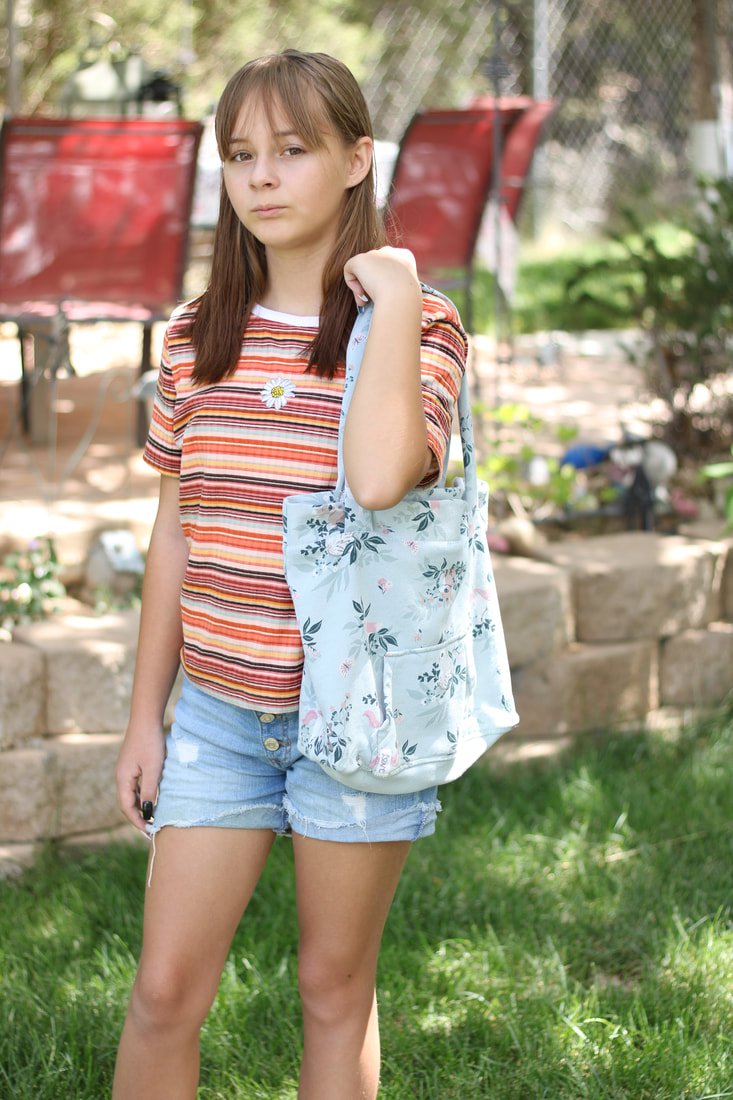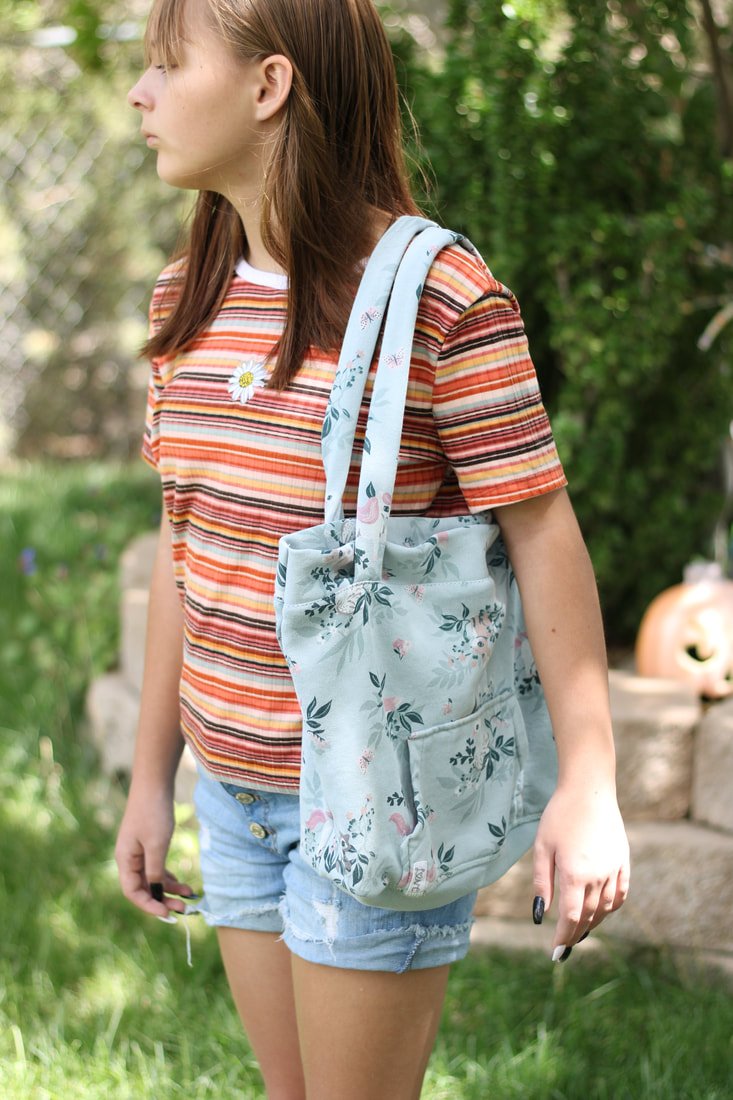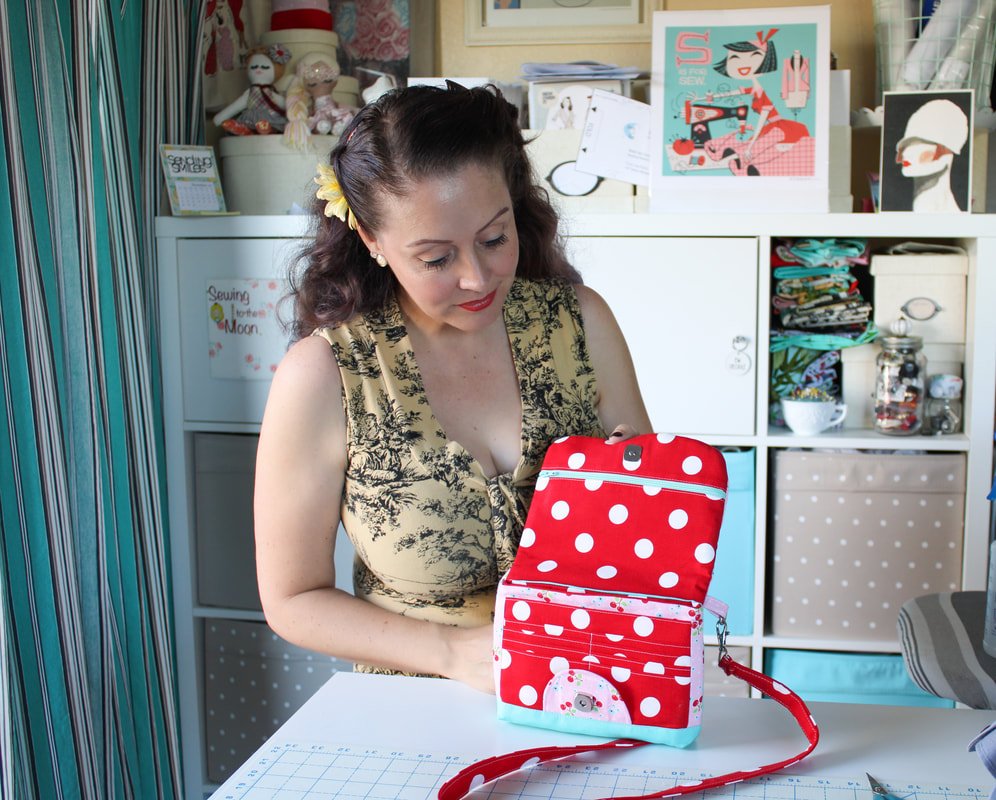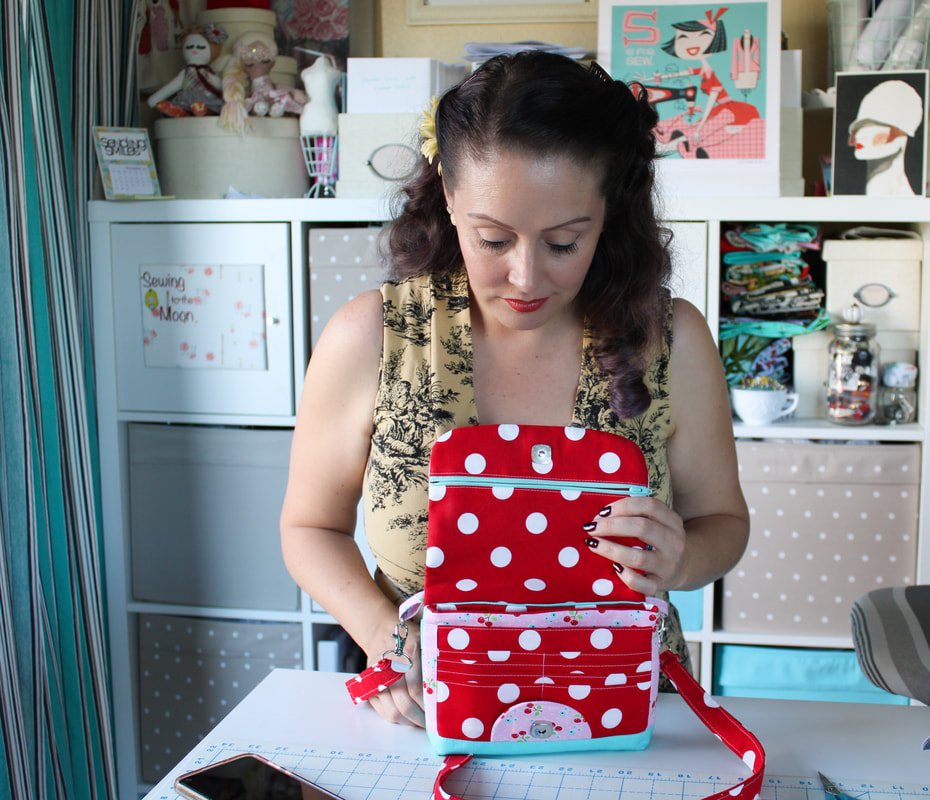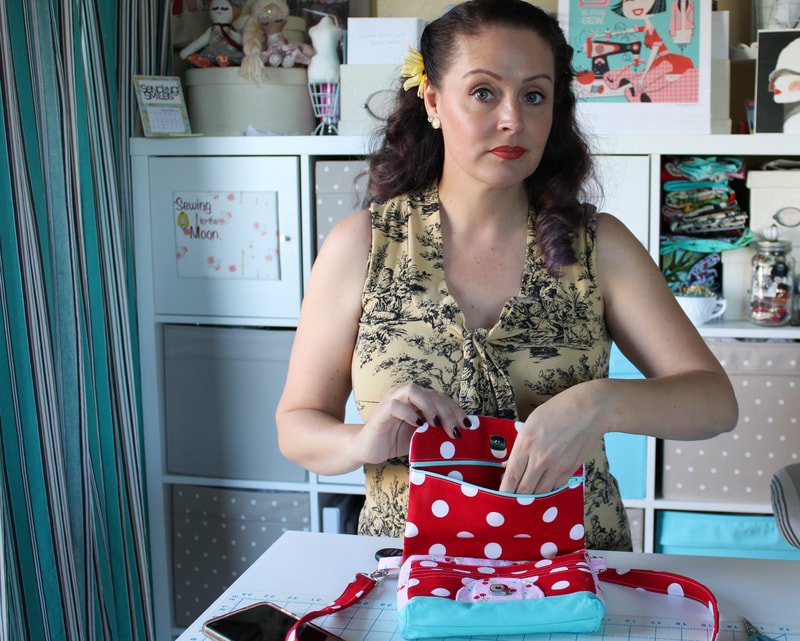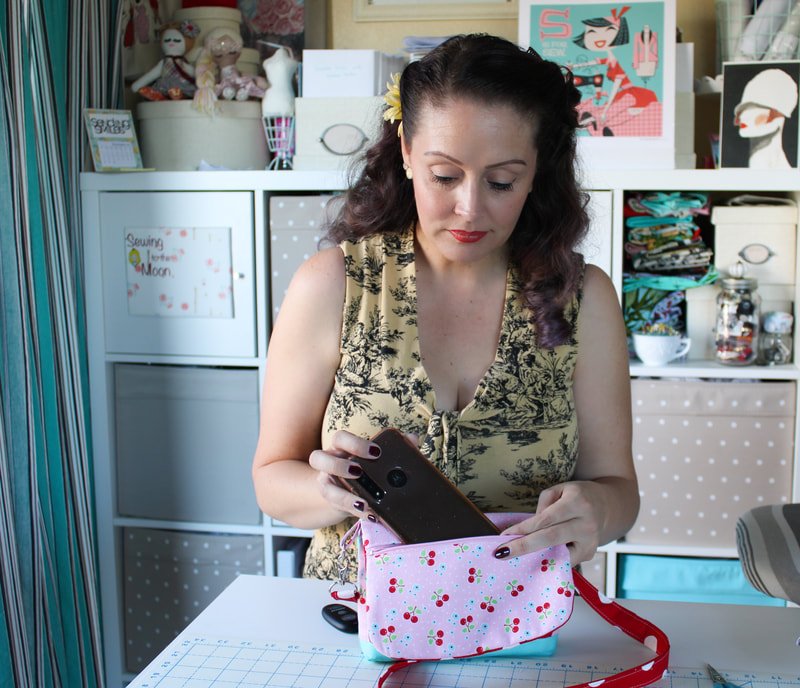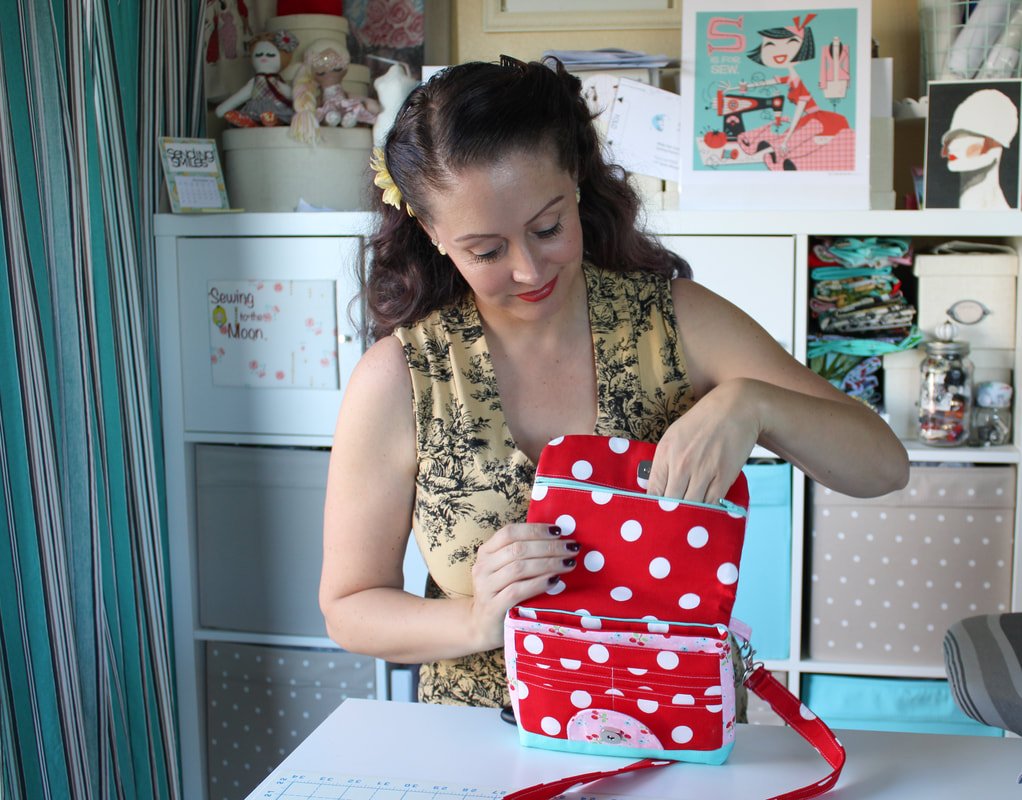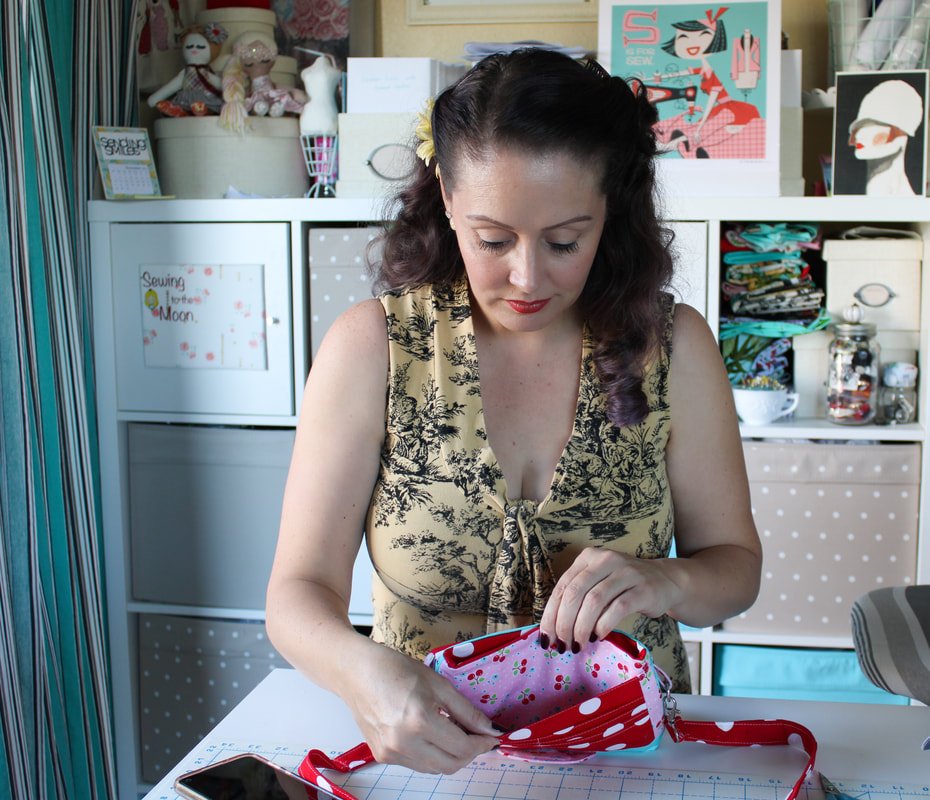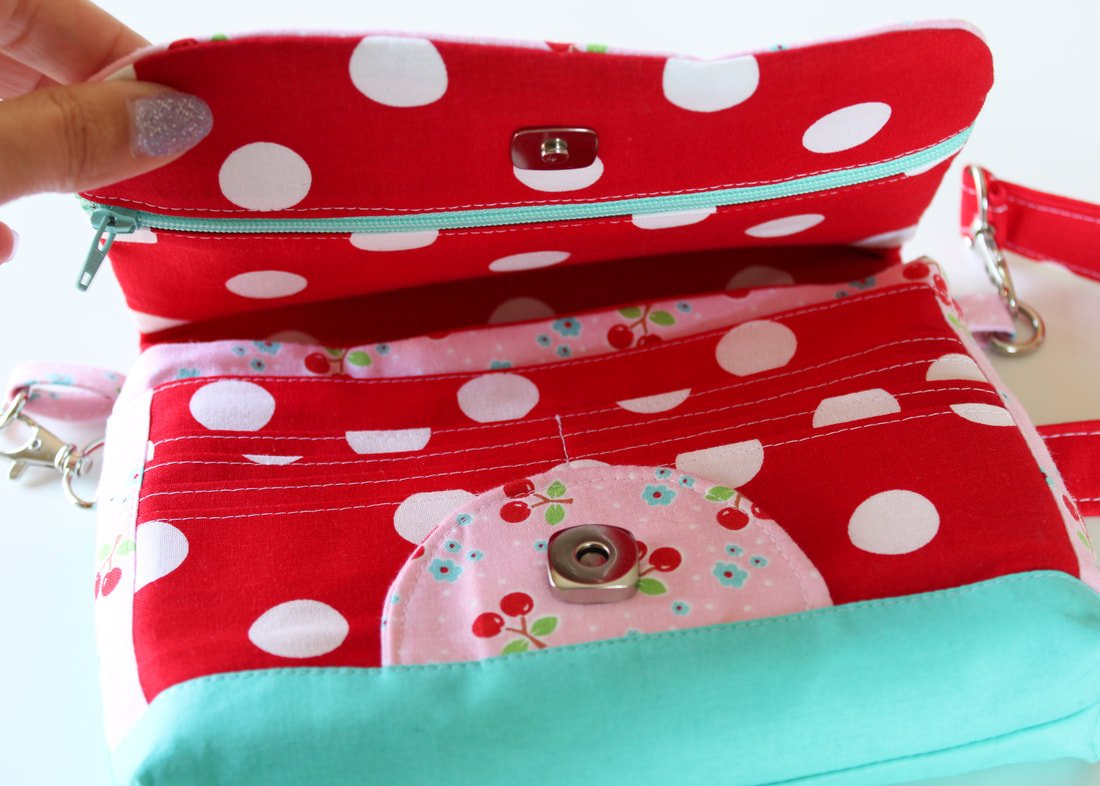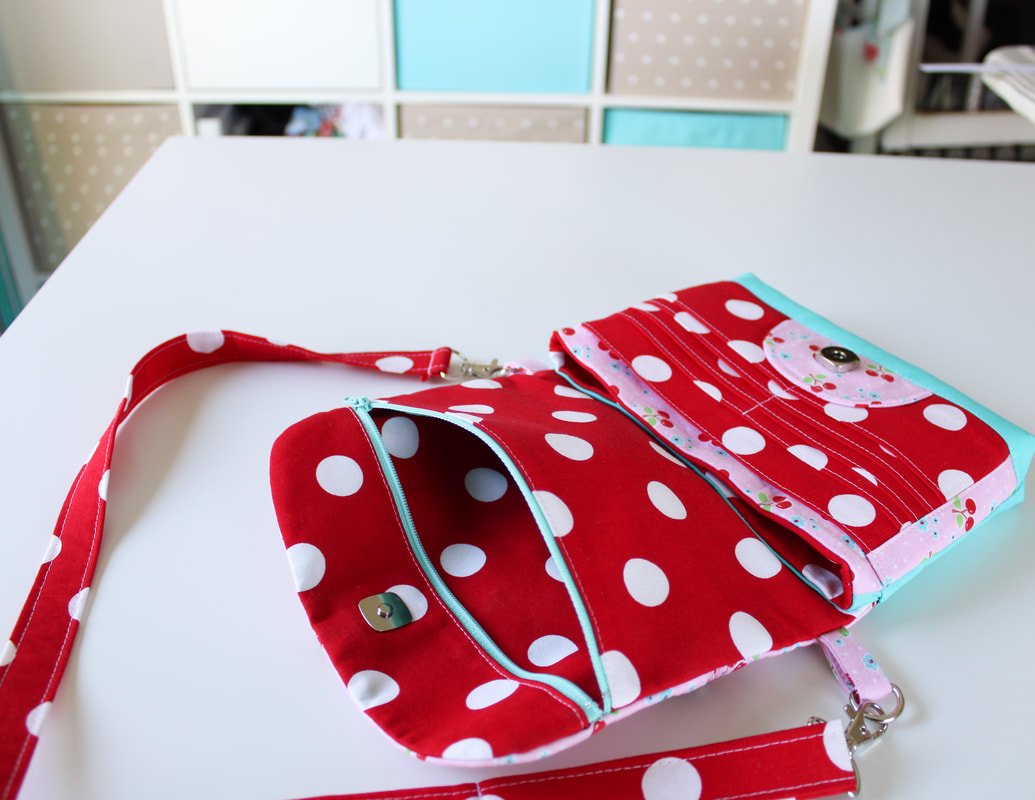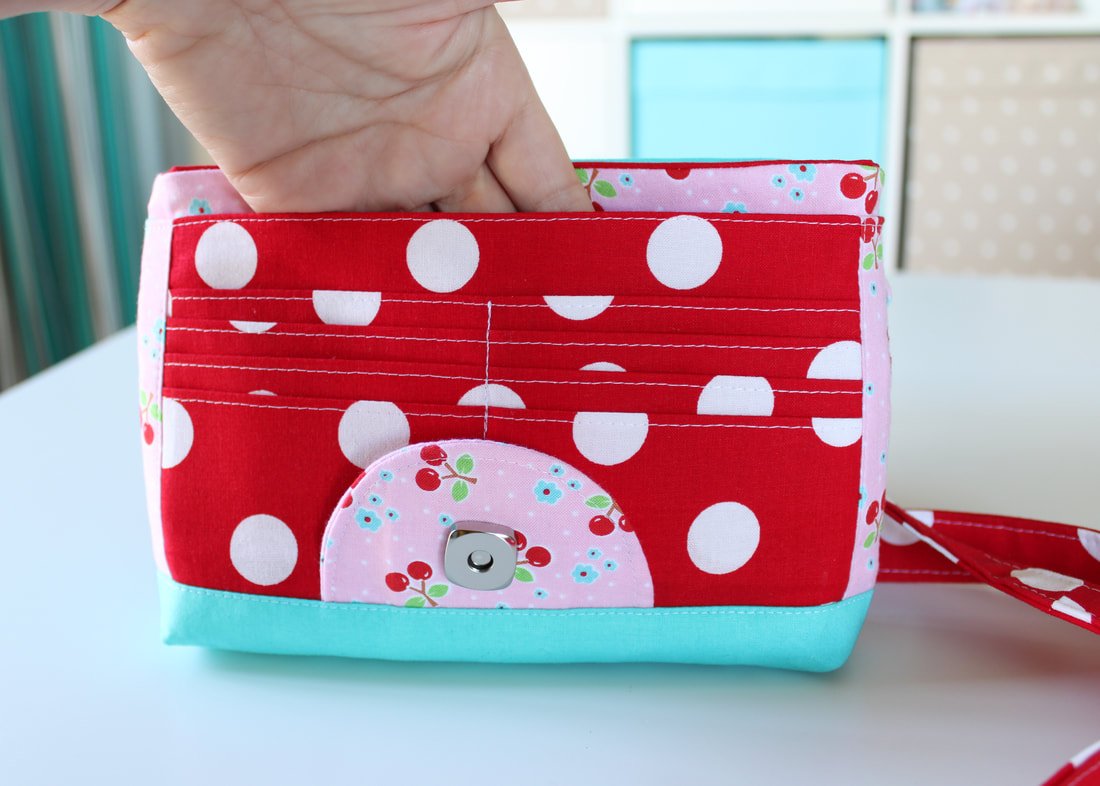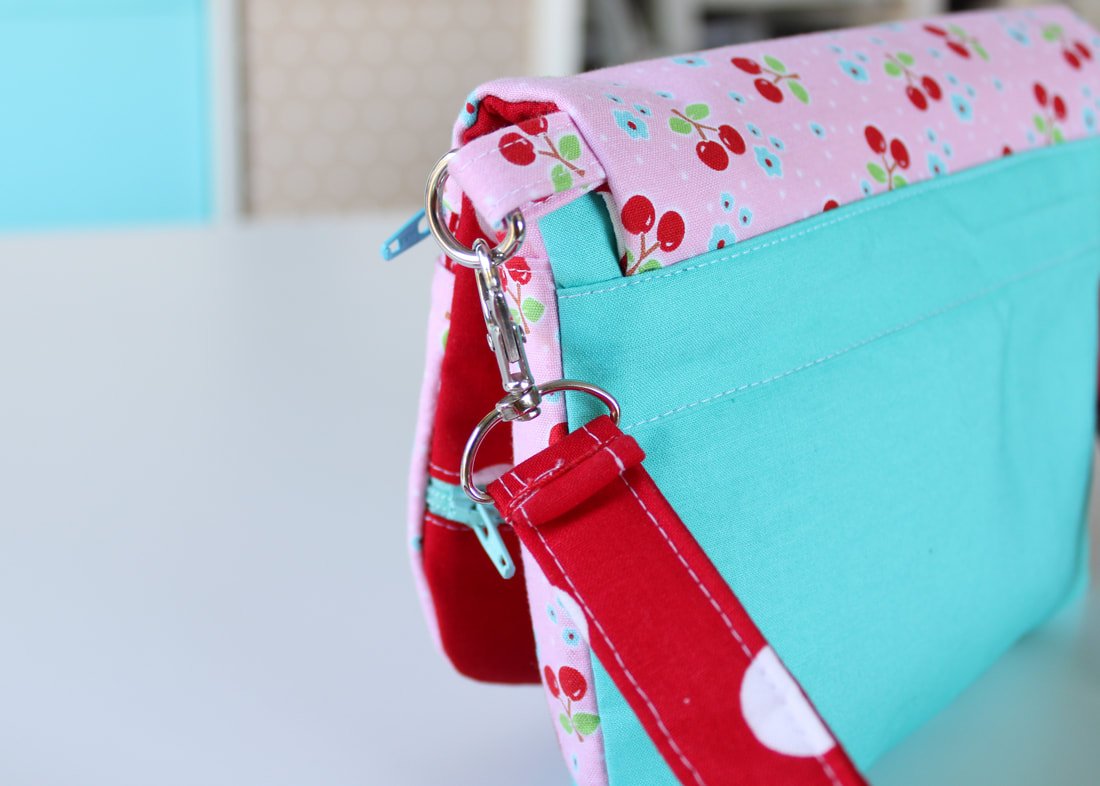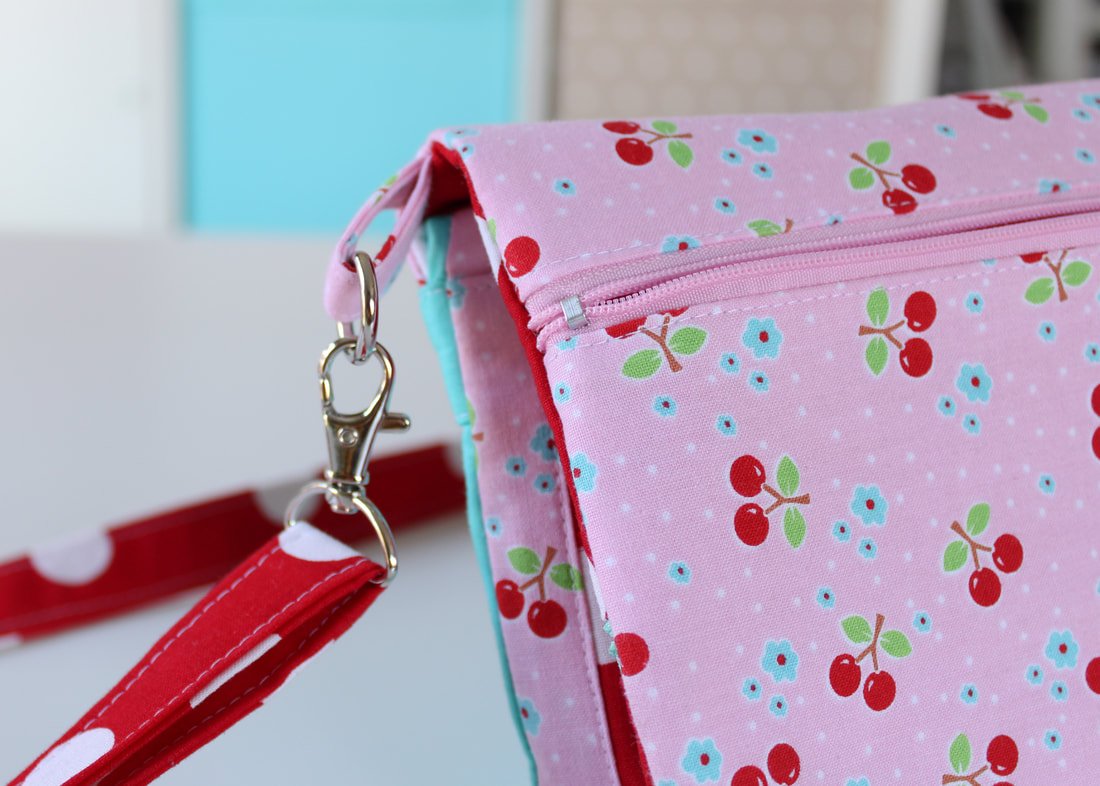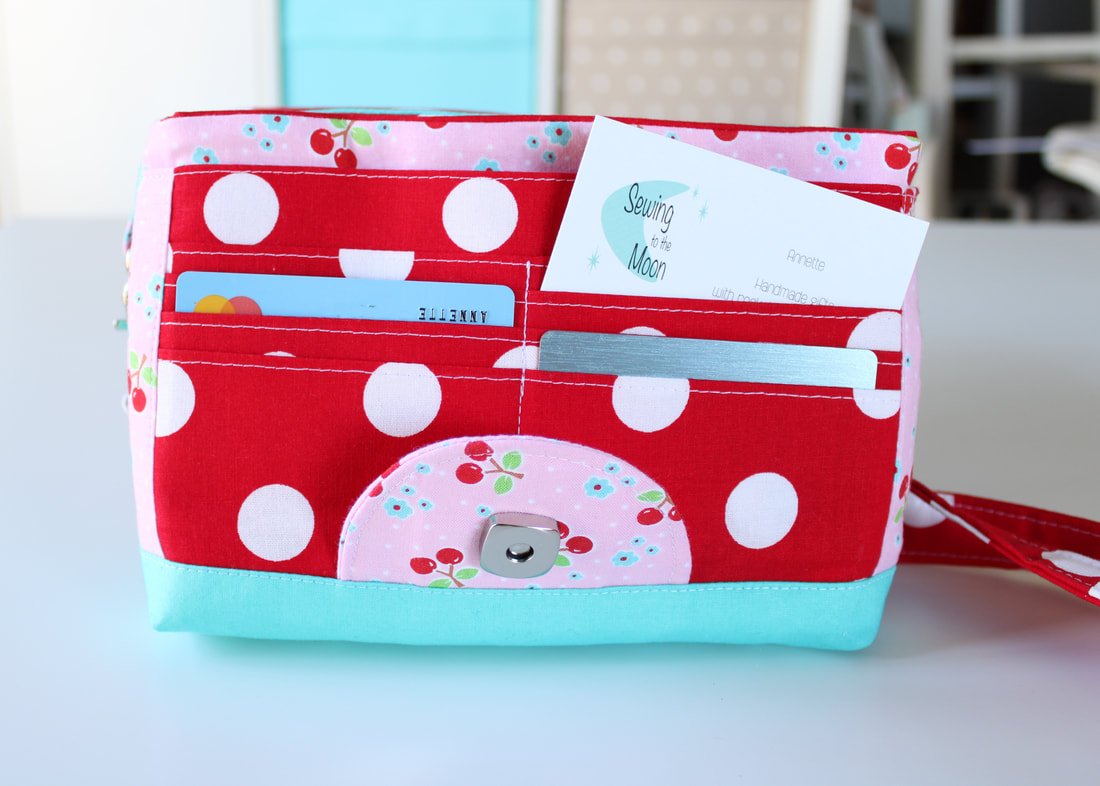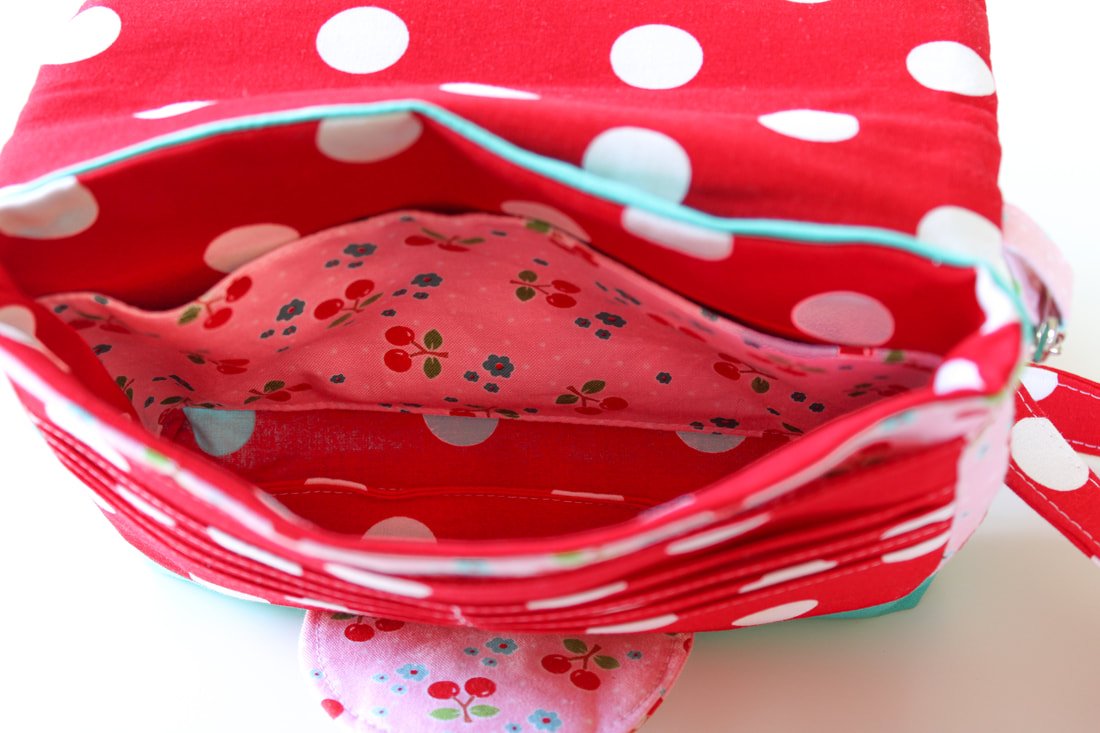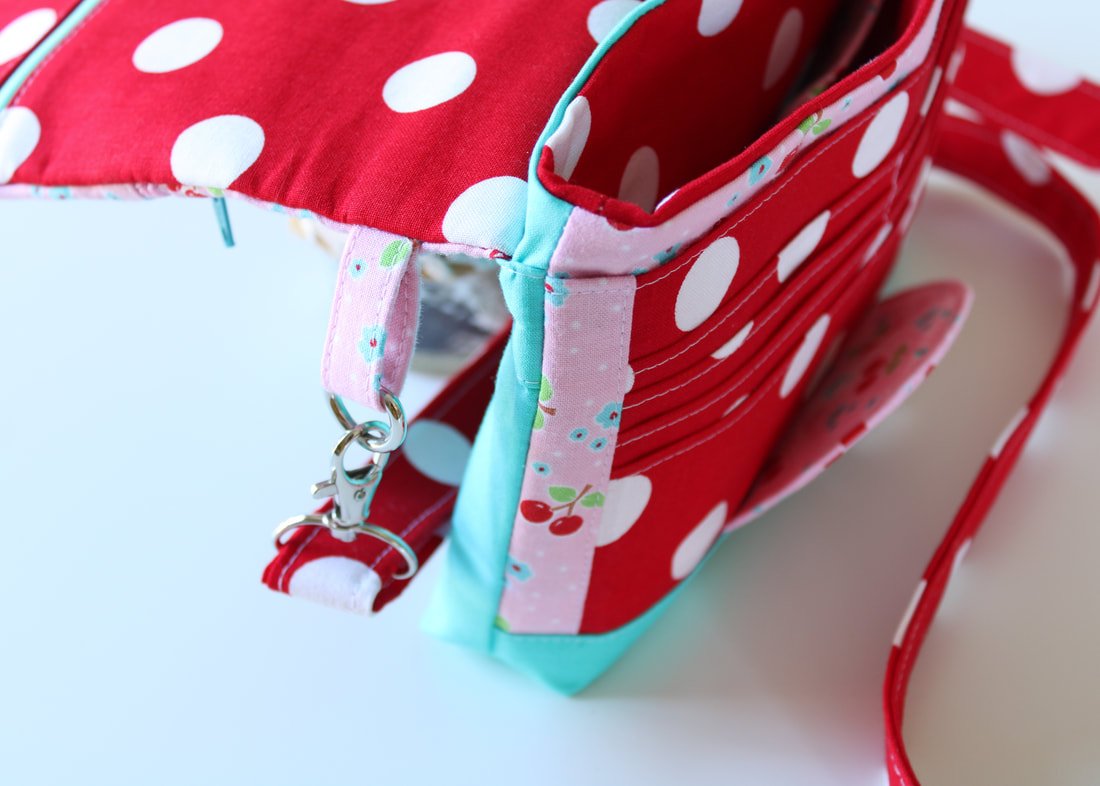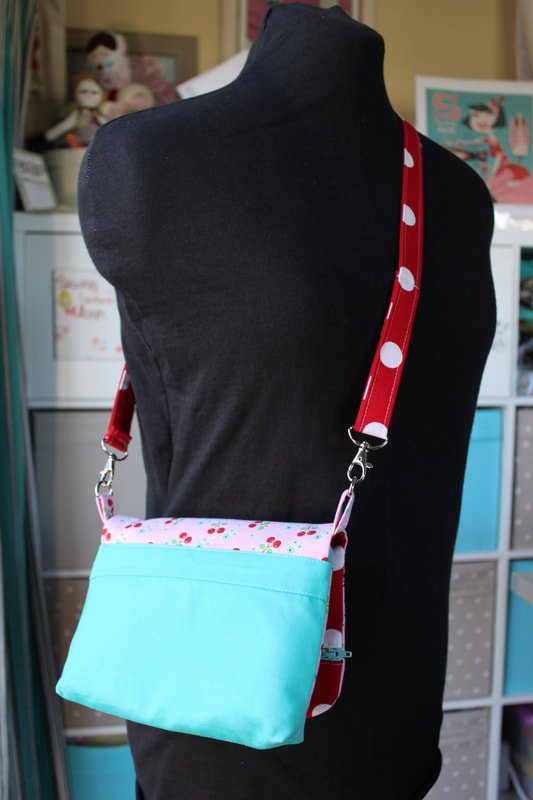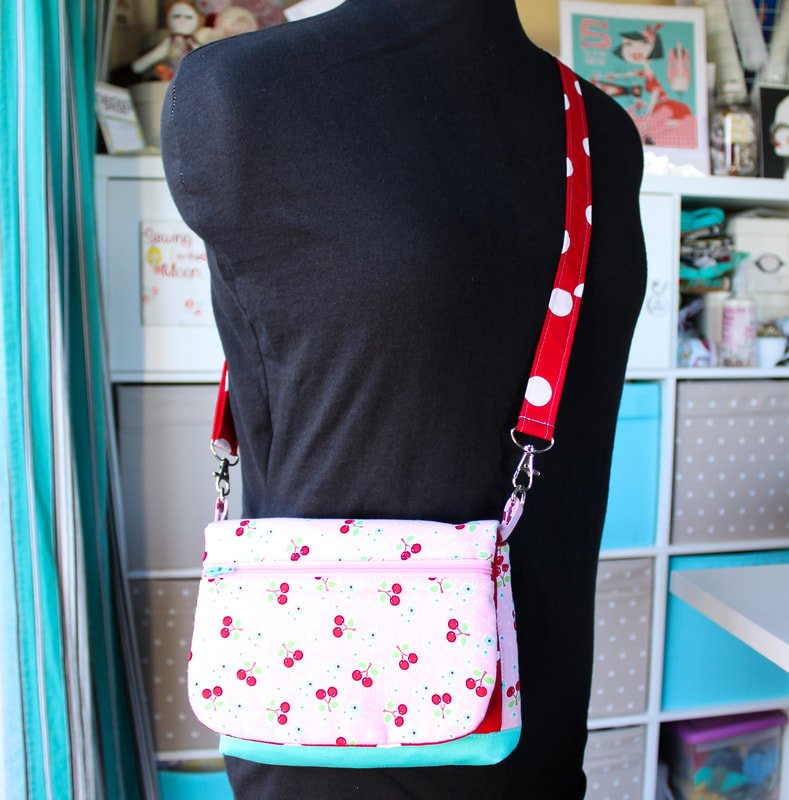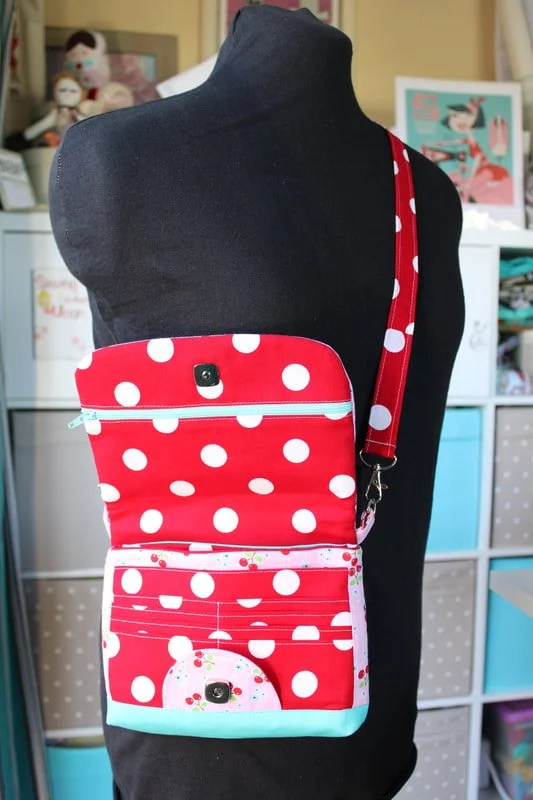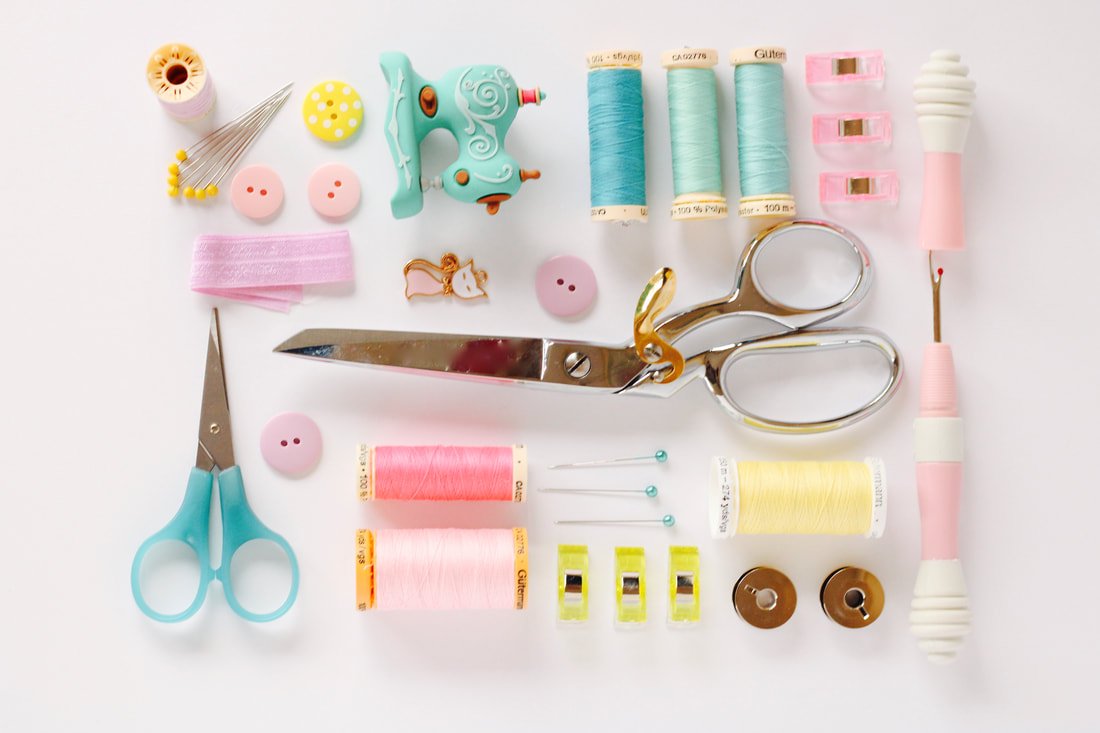
Pattern Reviews, Sewing Hacks, Tips & Free Patterns
Sewing Blog Besties
Beetlejuice Handbag by Swoon Patterns
I made a Beetlejuice Bag. It fits everything and the kitchen sink. This is the Annette Satchel by Swoon Patterns and is my favorite bag to take on a trip or for a full day of shopping. It’s big and I love it!
Coffee and sewing just go together!
Beetlejuice…Beetlejuice…Beetleju……Ha, I’m not saying it!
Do you ever feel like you need a bigger bag? All of your life doesn’t quite fit into your current bag, and it’d be nice to have a larger one, right? I sewed a big bag using Swoon Patterns “Annette Tote” sewing pattern. And, OMGSH! I am not joking when I say it’s a bigger bag. The bag is huge! I’ve made many Swoon patterns, and this one was no different. It’s well thought out, every pattern piece matches up, and the result is very professional-looking, as always.
I had some bright green Beetlejuice fabric and knew I wanted it for this bag. I also had black vinyl in my stash so, this was going to be a perfect bag for the spooky season. And, bonus, the new Beetlejuice movie came out around the same time I finished my bag. Yay!
If you’re new to bag-making, it can be a little intimidating. The most important thing is buying good quality interfacings and vinyl. Don’t skimp on these things. And, press, press, press.
Bonus, the pattern is my name, so you knew I was going to make a few of these, right?
Supply List:
By Annie’s soft n stable (there are other brands, but this is THE best) Also, available on Amazon
Sewing machine
Wonder Clips. Pins are nice, but clips are my go-to for bag-making, especially if you use vinyl or leather
Fabric for the outside (roughly1.5 yards)
Lining fabric (1.5 yards)
2 Zippers- 1 for interior pocket, 1 for bag
Interfacings
Rotary cutter and mat
Double-sided tape, I like Tandy leather
Chalk marker
Rulers
Iron and board
Marine Vinyl for handles and outside pockets, don’t skimp on this.
Purse feet (optional)
Metal hardware for handles
Matching thread
Printer, paper, and tape
I might have forgotten a thing or two, I’m going off memory here. There’s a whole list of what you’ll need in the pattern instructions. The fabric amount is probably wrong as well, make sure to check the pattern.
Annette Satchel first steps.
Interface everything!
After you’ve printed the PDF pattern, cut, and taped everything together, it’s time to start the bag.
Trace your pieces onto the fabric. Cut all the extra pieces there aren’t actual pattern pieces for.
Interface everything! You have to sew the foam to the interfaced fabric main pieces. A serger is nice for this, or use the zigzag stitch on your machine.
Cut out the vinyl handle pieces and place them onto the purse front and back. This is easy to do by folding the purse front in half and marking the CF. Use your ruler and chalk to mark placement spots for the handles. Use your double-sided tape to attach the handle in place.
Sew the handle connectors on.
Clip the 2 pieces of the side pockets together, matching placement points. This will feel funny, but it creates a nice big pocket. This pocket will fit a few cell phones, a small water bottle, a stuffed puppy, or a pair of flip-flops.
My Beetlejuice bag is coming along nicely.
Create the interior pocket. Leave a large gap in the bottom, this is how you will turn the bag right side out after it’s completed.
Purse feet are nice to have but not necessary.
You will sew the bottom base to the front and back of the bag. Topstitch. Below is what the outer will look like.
Now it’s time for the interior of the bag. I had some fun stripe fabric left over from a Halloween quilt I made last year. I didn’t have enough for the whole interior, but I made it work. Making bags is fun because you can use scraps for inside pockets and other small areas.
The intereior of the bag. Stripe fabric for the sides and Beetlejuice fabric on the bottom base.
Now the bag starts coming together.
Take the bag's main piece and side pocket pieces, and get your clips.
Start by clipping at the top, then the middle marked spot, and go from there.
Sew from one top edge, down and around, and up to the other edge. Repeat for both sides.
Clip, clip, hooray!
After the outside is finished, sew the interior the same way. This will be easier because there isn’t a layer of thick foam.
Add your own label. This is the chef’s kiss!
Clip around the top of the inside and outside. Sew!
Use lots and lots of clips.
Turn inside out through the interior pocket. This is tough, but you’ll persevere. LOL
The last step is to make the handles.
I usually make mine a little shorter or longer than what patterns call for. I measure the length I prefer with a soft measuring tape, draped over my shoulder.
Fold the handle in half, mark, then fold each side to the mark down the middle. Using the double-sided tape really helps with this part. Clip and sew.
When sewing vinyl, you cannot backstitch. The needle leaves permanent holes, so go slow and sew carefully.
Mark the center point, fold each edge to the line. Then fold onto itself, clip, then sew.
Insert into the hardware rings on your purse. Sew a few rows of stitching across the vinyl.
Dress accordingly and go see the new Beeltejuice movie.
That’s it! Your big beautiful handbag is ready to get filled with everything on the planet.
It’s a fairly simple handbag to sew. I’ve made the smaller version as well and love it.
I’ve never had a handbag this large before so, I do feel a little funny shopping with it. I haven’t knocked anything over inside a store, yet. Haha! Oh, and it takes up a whole seat at a restaurant, but it fits everything! My laptop and camera both fit inside, which is nice if I’m on a photoshoot.
Do you need a huge carpet bag like this? I plan on making another in a different fabric- one that is more suitable for year-round use. I also might make a third using some leftover camera fabric from this skirt project.
Here’s a silly reel I made on Instagram showing what fits inside the bag.
Happy bag-making!
Annette
Movie theater goofball photos.
DIY: Sweatshirt Into Tote Bag
DIY tote bag sewing pattern. Use up old hoodie sweatshirts to make into a bag. Easy free sewing project that is beginner-friendly. Reuse and upcycle sewing project. Use up old children’s clothing and turn their things into a bag. Tote bag sewing pattern.
When I was coming up with a title for this post, I kept thinking of the word Upcycle. But, I don't see it used as much anymore. Do you still use the word upcycle? I opted for the DIY term instead. Anywho, onto the post.
Have your kids outgrown some of their favorite clothes? They can't stay little forever, right? Maybe they have something they used to love that no longer fits. You might have a bin of clothing that you don't want to donate or don't know how to put to use.
A friend asked me if I'd make a bag from her daughter’s old hoodie. It was a rare occasion and I said yes! I was in a rut with my sewing and thought creating something new would pull me out of it. It worked! The result is super cute and useful, too. That's a win in my book!
If you have an old hoodie packed away that you don't want to get rid of, I have the perfect project for you!
I scoured the interwebs looking for a hoodie up-cycle project and found nothing. I was pretty surprised nothing showed up. There were tons of T-shirt projects, but nothing for sweatshirts. So, I went head first into this challenge. After reading this, I hope you'll pull out those beloved hoodies and put them to use.
Supply List
Old Hoodie without a zipper
Ruler
Rotary cutter and scissors
Chalk marker or disappearing ink pen
Sewing machine
Serger (nice but, not necessary)
Clips (pins work but, it's a struggle because the fabric is thick)
The usual sewing notions
A little creativity ;)
First, you'll want to measure the front. You need to figure out the size of the square or rectangle your bag will be. Use chalk or pen to mark it, and cut. I used as much of the sweatshirt as I could because it was a child's hoodie. I decided to leave the bottom ribbing on the sweatshirt to act as the bottom base for the bag.
Next, cut off the side seam allowances to remove bulk. Cut apart the hood, cuffs, and sleeves and set them aside.
Measure your sleeve length, you'll want to use as much of this as possible for bag detailing. Cut from the shoulder to the wrist, it has the least amount of stretch. I used as much width as I could get away with.
Cut each sleeve strip the same length and width. Pin together, wrong sides together. These will get sewn to the bag top, to add height and some detail. You can baste the edges together before sewing if you'd like but, it's not necessary.
Pin/clip the strips to the top of the bag front and back. Don't sew these on yet.
Take the hood and cut off the seam around the face opening. Both layers should separate and you'll have 2 hood pieces. Take one and measure and cut a 3" wide piece using the whole length. Do this with the second hood. These will be your bag handles.
Clip the handles inwards 2-3" from the sides. Sew with a 1/2" seam allowance. Do this on the front and back pieces.
There wasn’t a method to my madness. I didn't make this bag in any particular order.
I used a 1/4" seam but, you should use a 1/2" if you can. I was working with a small hoodie and decided to use a small seam allowance where I could.
If you have a serger, serge the edges to make it nice and clean. You don't need to do this, the fabric won't fray. I made this for something else, so I really wanted it to look nice inside.
Topstitch with seam allowance pointed down. Move handles out of the way.
Move the handles out of the way and topstitch the seam allowance down with 1/8". This will give the layers extra support.
Next, you're going to clip the sides and bottom together. Sew from one opening, down, and around to the next top. Make sure to backstitch at the beginning and end. Don't sew the top.
If you want to leave your bag like this, you're done! Ta-da! Super easy and it used up a hoodie that has probably been in a drawer or bin, unloved for a long time.
If you'd like to box the corners, keep following along.
Pinch bottom corner and match it the seam. Sew across.
I usually cut the triangles off but, decided to leave it on this time. The extra weight helps hold heavy books, tablets, etc. I stitched in the ditch to keep the triangle from flapping around inside. Just fold the triangle up and pin it in place, then stitch in the ditch (seam in the seam).
Or, simply cut off the excess triangle.
Ta-da! You're all finished. This would make a great gift for a child or anyone with a beloved hoodie lying around.
All finished!
The bag is a good size and will be loved and used for years, I'm sure.
I loved leaving the front pocket on so, others would know if was from a hoodie. Such a cute turnout.
This was the fabric that was left over. Not too bad.
There wasn't too much leftover fabric. I'm sure you could make another cute bag or add pockets inside.
I had my daughter model the bag so you could see the size reference. It's a good size!
Thanks for reading along!
Happy hunting and happier sewing,
Annette
Crossbody Bag Review
Sew the world’s best crossbody bag. It has tons of pockets, a long strap, it snaps closed, zippered pockets, and more pockets. You can fit everything you need for a full weekend getaway inside.
I have found the holy grail of crossbody bags and I'm shouting it out from the rooftop! Make this crossbody bag today, you won't regret it.
This bag is the biggest-little bag I've ever laid eyes on. It's a game-changer for sure and everyone needs to have one or two! It's honestly the best travel bag I've come across! You can fill it with everything except the kitchen sink. This day-use crossbody bag is perfect for walking around museums, theme parks, concerts, national parks, etc.
I'm not getting paid for this post, I am just in love! Haha!
I've always carried my regular handbag whenever we ventured out and after a few hours, my shoulder would hurt something fierce. I eventually bought a tiny crossbody bag from a big box store for $5 because it was $5! Oh, and it was in the shape of cherries. Super cute!!
Well, my newest phone is too big for the cherry purse. So, I searched Pinterest high and low for a crossbody sewing pattern and nothing came up. Is it me or is Pinterest extremely lackluster nowadays?
I wanted pockets and the bag shape to be more horizontal than vertical. My next stop was Etsy. Thank you Etsy, for coming through. I found the best pattern and I'm sharing it with you today. Hold on to your teacup because she's a doozy.
This bag has so. many. pockets! It's comfortable to wear (aren't all crossbody bags?) and will hold allllll of your things. I'm not sharing a step-by-step tutorial in this post because the bag creator has YouTube videos and an extremely detailed PDF that comes with the pattern. This post is more of a pattern review.
I made this one for myself so, it is full of bright colored fabrics. If you know me, I'm the opposite of a neutral person. Ha!
Clarendon Crossbody Wallet
by: Hold It Right There Bags
Grab the downloadable pattern here.
I want to start off by saying this bag is not great for scrap-busting. It takes a good amount of fabric. You'll also need a couple of yards of interfacing because everything needs to be interfaced. Don't skip the interfacings, bags really do need all the pieces to be reinforced.
After you print and cut out all the PDF pattern pieces, trace and cut the fabric pieces, and interface everything 'til the cows come home, you'll be ready to sew!
Whew!
Holy moly. This pattern has sooo many pieces. I suggest cutting and interfacing everything one day and saving the sewing for the next day. Like I said, she's a doozy.
The bag does come together quickly when you start sewing though. Yay for that!
I wore the bag all day on a family adventure to an aircraft carrier. It was full of all my things and a few of my kid’s things. I walked up and down stairs and spent a lot time standing, reading signs, and listening to the volunteers talk. The weight would usually have hurt my shoulder and back but, I didn't have any pain. I could have worn this bag for 3 more days without batting an eyelash. Winner-winner!
It held everything I needed for the whole day and was comfy to use/wear.
The following weekend I was invited to go away on a girl’s trip. I left my regular purse at home and only took the crossbody bag. It was perfect. It held my money, masks, cards, and everything else I needed for a whole weekend.
I do like a full-size handbag for everyday use so, when I got home I emptied everything back into my bigger bag. But, this was perfect for a day out.
This bag has all the pockets! It’s the greatest bag pattern I’ve ever sewn.
Assembling the bag is fairly easy. Follow the PDF directions and/or YouTube videos. There are a few added steps to help with things like zipper installation, which is great for beginners.
You don't need rivets to make this bag. You can sew across the seam easily enough. Heck, you don't even need the swivel hook or D ring. Sew one long purse strap into the bag seams.
Okay, here are a few changes I'd make:
Tips for Next Time
I wouldn't add the lining pocket. The bag is small and has a whole lot of pockets already. The main body portion is small enough and doesn't need the extra pocket (read: save your fabric).
I made the purse strap twice as thick. I always prefer a thicker strap so, if you're the same way, use a 1" swivel hook and double the width of the fabric strap. I still used a .5" D ring and didn't have any issues with the different hardware sizes.
Next time, I want to use vinyl for the back and bottom. I didn't use any this time because it's a cross body bag. I usually don't let my crossbody bags touch the floor, they stay on my body throughout the whole day. But, I might try it in the future.
I would make zipper tabs next time. This will allow the front flap to lie flat and look nicer. Yes, adding zipper tabs adds extra time but, it'll be worth it.
Read through the pattern instructions first. The instructions are extremely detailed. Almost too detailed in my opinion. But, if you're brand new to bag sewing, extra details are a good thing. If you're more familiar with inserting a zipper, snap, etc.) some steps may feel a bit tedious.
I would topstitch the front flap and around the main opening. The instructions don't have you do this. I suggest you do it though. Topstitching holds all the layers in place and gives it extra reinforcement.
Back view of the bag.
So what do you think? Are you excited to make a Clarendon Crossbody Wallet? I highly recommend this pattern and bag. I plan on making a few for friends to give as Christmas gifts this year. But, shhh, don't tell them. ;)
Happy Sewing!
XO,
Annette



























